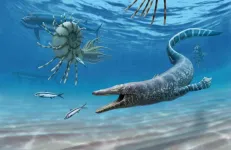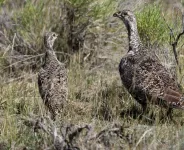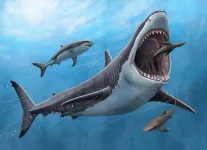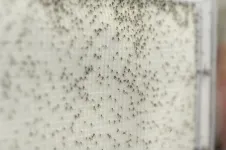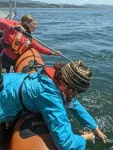UNF professor & Bureau of Land Management team discover ancient marine reptile fossil, publish ground-breaking evolutionary insight
2023-06-26
(Press-News.org) University of North Florida faculty member Dr. Barry Albright is part of a research team led by the Bureau of Land Management (BLM) who have unlocked new evolutionary information following the discovery of a 94-million-year-old mosasaur in the gray shale badlands of the National Park Service Glen Canyon National Recreation Area in southern Utah. Mosasaurs are fully marine-adapted reptiles that swam the seas while dinosaurs ruled the land. The ground-breaking research was just published in Cretaceous Research.
The journey began nearly 11 years ago as Scott Richardson, a trained volunteer working under Dr. Albright, searched for fossilized remains of creatures that once swam in a vast seaway that covered most of the middle of North America during the Late Cretaceous Period, between 84 and 95 million years ago. In March 2012, Richardson found numerous small skull fragments and vertebrae of what proved to be an early mosasaur scattered across a broad shale slope.
“During the time the Tropic Shale was being deposited, about 94 million years ago, mosasaurs were still very small, primitive, and in the early evolutionary stages of becoming fully marine adapted. For these reasons, their fossils are extremely rare and difficult to find,” said Dr. Albright.
A joint team from the BLM and National Park Service recovered nearly 50% of the specimen over the course of the next two field seasons, enough to determine its exact identity. Dr. Alan Titus, BLM Paria River District paleontologist, led a crew of BLM staff and volunteers on the research. The team included volunteer Steve Dahl who was later honored in the species name, Sarabosaurus dahli, or “Dahl’s reptile of the mirage.” The name alludes to both the ancient seaway in which this animal swam that has long since vanished and the mirages that accompany the region’s extreme summer heat.
“Mosasaurs from younger rocks are relatively abundant, but mosasaurs are extremely rare in rocks older than about 90 million years,” said Dr. Titus. “Finding one that preserves so much informative data, especially one of this age, is truly a significant discovery.”
The oldest mosasaurs are small, about 3 feet long, but they evolved into gigantic lizard-like marine predators that dominated the oceans during the latter part of the dinosaur age. Their land-dwelling ancestors were similar to the modern Komodo Dragon, but through time their aquatic cousins evolved streamlined bodies, paddle-like fins, and tails that propelled them through the water. Early forms were more lizard-like in appearance and retained relatively primitive tails and limbs, but Sarabosaurus possessed one important difference, a new way to circulate blood into its brain.
“Sarabosaurus sheds light on long-standing questions regarding the relationship of some early branching mosasaurid species, but also provides new insights into the evolution and antiquity of a novel cranial blood supply seen in a particular group of mosasaurs,” said Dr. Michael J. Polcyn of the University of Utrecht, Netherlands, and Southern Methodist University, Dallas.
About University of North Florida
The University of North Florida is a nationally ranked university located on a beautiful 1,381-acre campus in Jacksonville surrounded by nature. Serving nearly 17,000 students, UNF features six colleges of distinction with innovative programs in high-demand fields. UNF students receive individualized attention from faculty and gain valuable real-world experience engaging with community partners. A top public university, UNF prepares students to make a difference in Florida and around the globe. Learn more at www.unf.edu.
###
END
ELSE PRESS RELEASES FROM THIS DATE:
2023-06-26
Efforts to improve sage grouse habitat through conventional management practices may be ineffective -- and even counterproductive -- according to research by University of Wyoming and other scientists.
Sagebrush reduction strategies, including mowing and herbicide application, are often employed to enhance habitat for the greater sage grouse and other sagebrush-dependent species. The theory is that clearing large sagebrush shrubs improves food sources in sage grouse nesting and brood-rearing habitats by allowing ...
2023-06-26
Researchers at the University of California San Diego School of Medicine have led a study to examine a potential new treatment option for patients with nonalcoholic steatohepatitis (NASH)-related fibrosis.
The results, published in the June 24, 2023, online edition of The New England Journal of Medicine, found that a drug that mimics a hormone in the body improved both liver fibrosis, or scarring of the liver, and liver inflammation in patients with NASH.
“Identifying an effective drug for NASH is extremely promising for patients as currently there are no FDA-approved therapies for this condition,” said Rohit Loomba, MD, the ...
2023-06-26
BELLINGHAM, Washington, USA — The Journal of Applied Remote Sensing (JARS) has honored four of its best papers published in 2022. The awards recognize the journal’s best student paper, as well as papers in interdisciplinary applications, theoretical innovation, and photo-optical instrumentation and design.
JARS is published online in the SPIE Digital Library by SPIE, the international society for optics and photonics, and optimizes the communication of concepts, information, and progress among the remote-sensing ...
2023-06-26
HOUSTON – (June 26, 2023) – By 2030, if the 30 by 30 initiative supported by more than 100 countries is successful, 30% of our land and ocean ecosystems will be designated protected areas meant to safeguard biodiversity and help limit the impacts of climate change.
However, a study by Rice University ecologist Lydia Beaudrot and collaborators reports for the first time that tropical mammals living inside protected areas are not spared the effects of human activity even when it occurs outside of the protected boundaries.
Based on the ...
2023-06-26
University of Oklahoma assistant professor Xiaochen (Angela) Zhang, Ph.D., has received a prestigious Faculty Early Career Development Award, known as a CAREER award, from the National Science Foundation to study how relationships among non-profits, community groups and local government agencies can improve disaster resilience, resource allocation, and emergency management by enabling organizational interactions, rather than top-down responses.
Zhang, who is an assistant professor of public relations for the Gaylord College ...
2023-06-26
MINNEAPOLIS/ST. PAUL (06/26/2023) — A new study shows that current trends in environmental degradation will lead to large economic losses in the coming decades, hitting the poorest countries hardest. But there is hope: investing in nature can turn those losses into gains.
Researchers from the University of Minnesota and Purdue University published their findings in Proceedings of the National Academy of Sciences. The team developed a first-of-its-kind, global earth-economy model to capture interactions ...
2023-06-26
William Paterson University PRESS RELEASE
EMBARGOED UNTIL MONDAY, JUNE 26, 2023, 3:00 PM EST
WAYNE, NEW JERSEY — A new study shows that the gigantic Megalodon, or megatooth shark, was warm-blooded. This latest research on the Megalodon, which lived in the world’s oceans from 23 million to 3.6 million years ago and measured about 50 feet in length, appears in the peer-reviewed journal Proceedings of the National Academy of Sciences.
The study, conceived of and led by Michael Griffiths ...
2023-06-26
The largest marine predator that ever lived was no cold-blooded killer.
Well, a killer, yes. But a new analysis by environmental scientists from UCLA, UC Merced and William Paterson University sheds light on the warm-blooded animal’s ability to regulate its body temperature — and might help explain why it went extinct.
After analyzing isotopes in the tooth enamel of the ancient shark, which went extinct about 3.6 million years ago, the scientists concluded the megalodon could maintain a body temperature that was about ...
2023-06-26
University of Calgary researchers have discovered how Leishmania parasites hide within the body to cause Leishmaniasis. The tiny parasites are carried by infected sand flies. Considered a tropical disease, one to two million people in more than 90 countries are infected every year. Effects range from disfiguring skin ulcers to enlarged spleen and liver and even death.
This chronic disease has been difficult to detect in the early stages. Scientists realized that the parasite was somehow manipulating immune cells but this process had not been well understood.
“This is the first study that shows how the parasite stalls the process of regular ...
2023-06-26
CORVALLIS, Ore. – Oregon State University researchers estimate that gray whales feeding off the Oregon Coast consume up to 21 million microparticles per day, a finding informed in part by poop from the whales.
Microparticle pollution includes microplastics and other human-sourced materials, including fibers from clothing. The finding, just published in the journal Frontiers in Marine Science, is important because these particles are increasing exponentially and predicted to continue doing so in the coming decades, according to researchers Leigh Torres and Susanne Brander.
Microparticle pollution is a threat to the health of ...
LAST 30 PRESS RELEASES:
[Press-News.org] UNF professor & Bureau of Land Management team discover ancient marine reptile fossil, publish ground-breaking evolutionary insight
